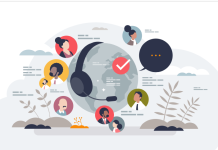
Most of us understand the idiom “growing pains” as it relates to the stresses of actual physical human growth in ourselves and/or in our children. It is also a reference to experiencing challenging and painful times in our personal and professional lives.
The expression “dates from the late 1800s, and originally referred to the joint and limb aches experienced by youngsters who are growing rapidly. By about 1900 it was being used figuratively.”
It is fair to say that the idiom “growing pains” has been with us for a very long time. We have applied it to temporary challenges in life and business for more than a century. Growing pains for Contact Centers and the organizations they serve occur both in new and well-established Centers. Growth creates significant organizational and operational disruptions. But like so many things in the Contact Center, good planning and execution reduces and relieves the growing pains.
“Growth hurts because change isn’t easy; that’s why they call it growing pains.”
—Tony Gaskins,
Motivational Speaker and Author
Unfortunately, there are some Contact Centers in which growing pains are a constant condition. Out-of-control growth, poor cross-functional relationships, and an environment of competing priorities at every level create a kind of chaos. However, growing pains ought not be a chronic condition. The idiom has been defined as “temporary,” a very forgiving term since “temporary” means “not permanent.” This can translate to “not now” over the long term and the pain continues. The good news is that growing pains in business not only can be treated, they can also be avoided!
In order to minimize your Contact Center’s growing pains, consider conducting a Growth Readiness Assessment to identify pain points, growth opportunities, strengths, and weaknesses and recommend both short- and long-term solutions.
Understand Your Path and Outcomes
Since growing pains are related to well, growth, it helps tremendously to know what is coming your way. Make it the Contact Center’s business to have a clear understanding of your company’s strategic objectives for growth (market share) and efficiency (margins) and their part in servicing that growth. Whether by new consumers, expanding locations, new product/service offerings, loyalty programs, self-service, or additional channels, the Contact Center will be impacted. You must know the business objectives to be prepared to serve.
The good news is that growing pains in business not only can be treated, they can also be avoided!
Familiarize yourself with company goals to align efforts, tasks (budget), and outcomes to business strategy. This alone reduces the likelihood of growing pains. For the most part, Contact Centers are cause and effect environments, full of “if and then” statements. For example, “if the Center has the right number of agents, then Service Level will be met.” Conversely, “if the Center does not have the right number of agents, then Service Level will not be met.” It is all a matter of outcomes, so evaluate your desired Contact Center outcomes. It is a fitting place to assess readiness for growth.
Examine Staff Turnover
One of the biggest Contact Center pain points these days is high turnover coupled with low unemployment rates. This makes recruiting a challenge, shifts many resource roles, and makes it extremely painful when it comes to Contact Center operations and outcomes. Turnover is also bad for margins, as loss of talent has a significant cost. The estimates for replacing Contact Center agents range from $5,000 to $20,000 per agent. Unusually high or sudden agent turnover is an outcome. It is an indication of an organization in crisis and people are jumping ship.
Contact Centers must also look at the loss of managers, supervisors, operations team members, etc., as an additional and sure sign of discontent. This loss typically accompanies poorly managed growth – aka growing pains! Growth is managed through planning and digging deeper to identify what needs to change in order to increase staff retention at all levels.
If your Contact Center has high turnover, it is likely that productivity rates are going down as fast as turnover rates are going up. As the Contact Center works to replace lost staff, managers and supervisors shift priorities. They move from supporting existing agents to onboarding new ones at a time when existing staff is handling a load that far surpasses their capacity. And sometimes, they are asked to do even more! The growing pains intensify and your “growth readiness” must be set at zero until the workforce is stabilized.
Identify Key Functional Areas
In addition to staff turnover and productivity, frailties are likely to be found in Contact Center functional areas. These include workforce management, training, and quality. Workforce management is a function that includes forecasting staffing needs, preparing schedules, reporting on performance, conducting business analytics, developing reports, and monitoring intraday demand and capacity.
Many Contact Centers assign the above tasks as a “shared responsibility” done by either managers, supervisors, or even team leads. This model may have worked when the Center had maybe three to 25 agents. But there is a point where the Contact Center’s growth needs organizational and operational changes to be successful. When Contact Centers grow, important duties cannot be just another task added to a long list of competing priorities.
It may be time to create a Business Support Team and hire staff dedicated to handling specific Contact Center functions. The hiring of an Operations Manager and a Business Analyst is a good place to start to relieve the pain. You are investing in a team dedicated to forecasting demand and building capacity models that support growth and make compelling cases for a supporting budget.
Formalize Training
Training is also often a “shared” duty, with instructional design a missing link. Lack of poorly developed training causes agents to have growing pains. They lack targeted training and tools to efficiently complete the transactions they are asked to handle. Training must have dedicated resources and skill sets that expand and broaden the definition of training itself.
Training begins with new-hire training and that is only the beginning. Training provides and supports knowledge bases, job aids, and training for new processes, products, and procedures. Training works closely with the quality team to improve the outcomes of new hire-training and identify trends in performance that may be resolved via additional training or process improvement.
Training as a “shared” responsibility is generally a throwback method to a smaller operation. Good leaders recognize the related “growing pains” and commit to build a strong operational infrastructure that values and promotes training.
Determine Effectiveness of Quality Program
When growth is overwhelming, frailties in your quality program are exposed. Quality is also one of those areas that may be assigned to a team lead or supervisor – often without the benefit of specific training in coaching and communicating feedback. Calibration related to scoring is necessary but insufficient to sustain a program over the long term and produce empirical evidence of its success. These include decreased error rates, increased customer satisfaction, and stabilized handle time.
Keep in mind that business growing pains are highly curable and totally avoidable!
Do not confuse the act of listening to recorded calls and completing a form to having a successful quality program. Growth and efficiency benefit from quality.
A “quality” experience on a consistent basis is an outcome. It is critical to assess the effectiveness of your program and determine if it is in the right hands. Either provide training for coaches or suspend the program until that training is properly executed. Quality takes a lot of time and time is a precious commodity. Use it wisely to manage growth and reduce pain.
These are just some of the top-line activities of a Growth Readiness Assessment. It is enough to get started on a plan to turn growing pains into a plan of action that relieves the pain and makes the model for growth a smooth one. Keep in mind that business growing pains are highly curable and totally avoidable!



